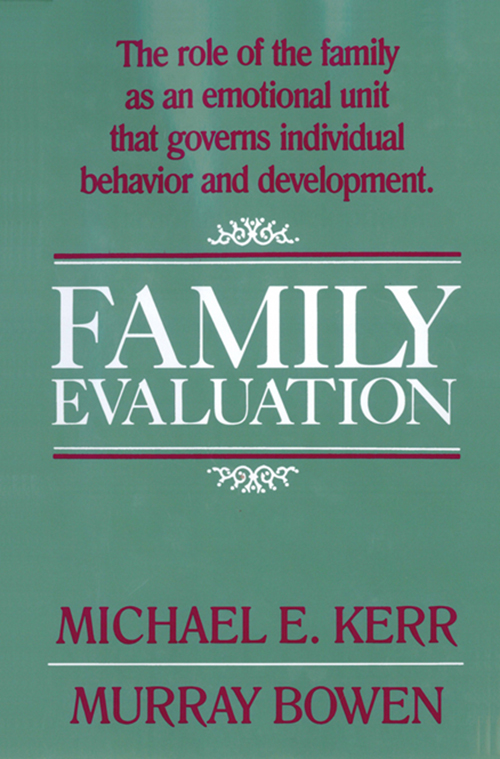
FAMILY
EVALUATION

AN APPROACH
BASED ON BOWEN THEORY

FAMILY
EVALUATION

AN APPROACH
BASED ON BOWEN THEORY

Michael E. Kerr, MD
and
Murray Bowen, MD
THE FAMILY CENTER
GEORGETOWN UNIVERSITY HOSPITAL

W. W. Norton & CompanyNew YorkLondon
Copyright 1988 by Michael E. Kerr and Murray Bowen
All rights reserved.
Published simultaneously in Canada by Penguin Books Canada Ltd., 2801 John Street, Markham, Ontario L3R 1B4
The Library of Congress has cataloged the printed edition as follows:
Kerr, Michael E., 1940
Family evaluation.
Bibliography: p.
Includes index.
1. Family psychotherapy. 2. Problem familiesEvaluation. 3. Bowen, Murray, 1913- II. Title.
[DNLM: 1. Family. 2. Family Therapy. WM 430.5.F2 K41f]
RC488.5.K48 1988 616.89156 881671
ISBN 0-393-70056-9
ISBN 978-0-39307-555-7 (e-book)
W. W. Norton & Company, Inc., 500 Fifth Avenue, New York, NY 10110
www.wwnorton.com
W. W. Norton & Company Ltd., 37 Great Russell Street, London WC1B 3NU
While the evaluation of a clinical family is an enormously complex task, it is an orderly process because each of its facets has a basis in theory. This book is written with the hope that by describing how the evaluation of a family is done, and how the data are then interpreted, the clinician will better appreciate this interrelationship between theory and practice.
Whenever a clinician begins to treat a clinical problem, his first step must always be to assess the nature of that problem. While such a statement provokes little disagreement among clinicians, it is amazing just how many treatment failures result from an inadequate assessment of the important variables influencing a given clinical situation. Effective therapy depends on assessment; if that assessment is too narrow in scope, the therapy will probably be ineffective. There are numerous examples of inadequate assessment undermining the effectiveness of therapy. A physician can repeatedly prescribe a diuretic for a patient with leg edema, but fail to recognize that the patient is in chronic heart failure. As a consequence, the edema keeps recurring. A psychiatrist can hospitalize a schizophrenic patient, but not appreciate how the problematic relationship between the patient and his parents has contributed to the hospitalization. The patient may improve and be discharged, but be rehospitalized a few months later. A family therapist may treat two parents and their schizophrenic son, but not attach importance to the fact that the parents are emotionally cut off from their families of origin. The parents cut off from the past undermines their ability to stop focusing on their sons problems; once again, the therapy will be ineffective.
The treatment of each of these situations would have been more successful if the clinicians evaluation of the problems had been broader, thereby including more sets of variables. Developing and retaining a broad perspective on clinical problems is not a simple task. A major obstacle to achieving this more comprehensive view lies in the limits imposed by the narrowness of the clinicians conceptual framework. The clinician sees only as far as his concepts for understanding problems permit him to see. If he thinks of bacteria as the cause of the infectious diseases, then he concentrates his therapy on killing bacteria. Should the patient have recurrent infections, then more antibiotics would be prescribed. The clinicians therapeutic approach is guided, in other words, by his conceptual framework. The clinician is thinking, If I can just control the activity of these bacteria, then I will solve this patients problem. Another clinician may have a conceptual model that considers the patients interpersonal relationships to be a factor influencing his vulnerability to infections. If this clinicians patient appears with a recurrent infection, he will reevaluate the physiological variables, but he will also begin to consider and inquire about the patients marriage, family and other close relationships.
While many clinicians have long recognized the importance of assessing variables from many levels of observation, it has been difficult to do this in the absence of an integrative theory. An integrative theory would provide a systematic way of collecting, organizing and integrating information from all levels of observation. In the absence of such a theory, there is a strong tendency in all clinicians to compartmentalize knowledge and to focus treatment on a particular compartment. Clinicians become knowledgeable about and develop therapeutic expertise in specific areas, but frequently attach too little importance to areas outside their knowledge and expertise.
While a satisfactory integrative theory does not yet exist, an important step toward the eventual development of such a theory occurred within psychiatry during the 1950s and early 1960s. This step was the development of family systems theory by Dr. Murray Bowen. There are two reasons why the development of this theory is so important. The first is that family theory defined an important new set of variables that influence the physical diseases, emotional illnesses, and social acting-out problems. The second is that the theory demonstrated that the interrelationship of these newly defined variables could be understood with systems thinking.
Family systems theory radically departed from previous theories of human emotional functioning by virtue of its conceptualization of the family as an emotional unit. Psychoanalytic theory, for example, which had been developed through the study of individual patients, had only been able to see the family as a collection of relatively autonomous people. Each family member, in other words, was motivated by his or her own particular psychological mechanisms and conflicts. Psychoanalytic theory did have the concept of object relations, which was sometimes invoked to account for what transpired in relationships; however, this was not really a relationship concept. It was rooted in the psychology of the individual. Family systems theory, on the other hand, viewed the family as a unit, as a network of interlocking relationships. These interlocking relationships, which were assumed to be governed by the same counterbalancing life forces that operate in all natural systems, were seen to have an enormous impact on the thinking, feelings, and behavior of each family member. Each person was not an autonomous psychological entity, but, instead, was strongly influenced by the family relationship system. These family concepts were developed from the study of relationships and pertained to relationships. The psychology of the individual was not ignored, but was simply placed in a larger context. The traditional psychological concepts were seen to describe rather than to account for
Next page











